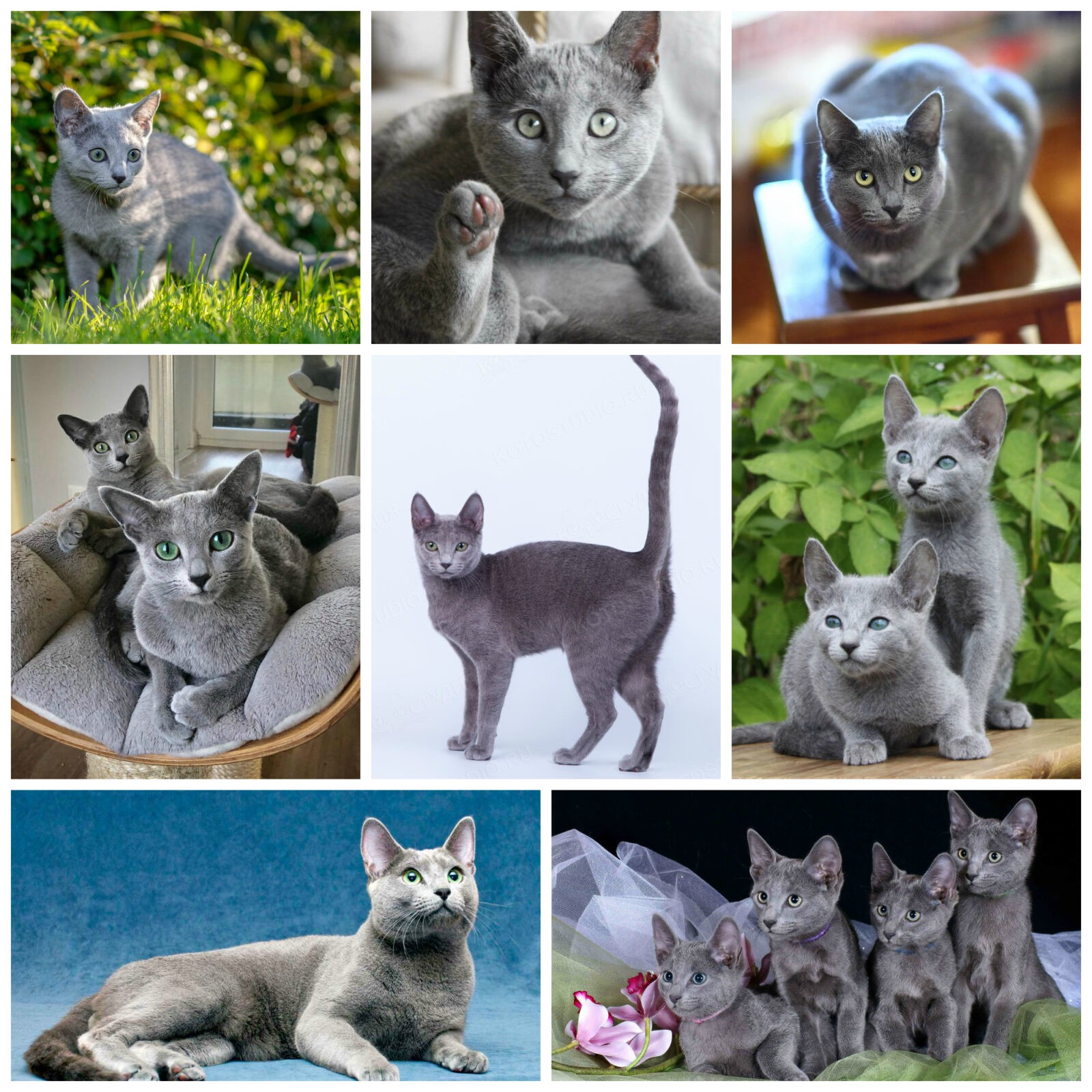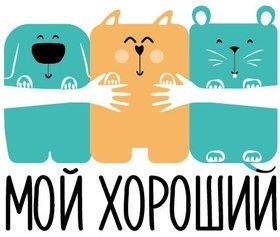
Brief description of the breed
The coat of Russian Blue cats is short and silky, and has the same length as the undercoat. Thanks to this property, the hair seems very thick. Color is a distinctive feature of these cats. The norm is a uniform blue color with a distinct silvery tint. Cats of this breed are very graceful, as they have a refined body with a wedge-shaped head.
basic information
| Breed name: | Russian blue cat |
| Country of origin: | Russia |
| The time of the birth of the breed: | unknown |
| The weight: | 2 - 7 kg |
|
EMS code:
|
ENG |
| Life Expectancy: | 10 – 20 years |
| Kitten price: | 20 – 300 $ |
| Most popular nicknames: | list of nicknames for Russian blue cats |
Assessment of breed characteristics
|
Adaptability
(A definition that means how easily a cat can adapt to changes in life)
|
🐱🐱🐱 |
|
Shedding level
(Level and frequency of hair loss in the animal)
|
🐱🐱🐱 |
|
Tenderness level
(The level and amount of tenderness and affection that the cat gives in return for attention to itself)
|
🐱🐱🐱 |
|
Social need
(The required number of contacts of a cat with other animals, as well as people)
|
🐱🐱🐱 |
|
Grooming
(The number of bathing, brushing, and the number of professional grooming sessions required for the cat)
|
🐱🐱🐱 |
|
Friendliness in an unfamiliar environment
(Features of the cat's behavior in a society with strangers or in an unfamiliar environment)
|
🐱 |
|
Health issues
(Potential health status of a cat)
|
🐱 |
|
Intelligence
(The ability of a cat to think and solve emerging difficulties)
|
🐱🐱🐱 |
|
Friendliness to children
(A factor that determines how friendly a cat is to children, whether she likes to play with them and tolerate some childish pranks)
|
🐱🐱🐱 |
|
Game activity
(The concept is determined by its very name, and, as a rule, is found in almost all cats)
|
🐱🐱🐱 |
|
Dog friendly
(The tendency of a cat to find a common language with a dog)
|
🐱🐱🐱 |
Photo of Russian blue cat:

The History of the Russian Blue Cat
The history of the Russian blue is not fully understood. The reason for this is the fact that these cats at different times they had different names, so it was not possible to reliably establish the origins of the breed. According to one version, the Russian blue cat in the middle of the nineteenth century was brought by an unknown sailor from Russian Arkhangelsk to England. In foggy Albion, cats of this breed began to be called "Arkhangelsk cats." A little later, other names appeared, the main ones being: “Maltese blue cat” and “Spanish blue cat”.
The mysterious origin of cats and their extraordinary and catchy color still could not contribute to the rapid popularization of the Russian Blue. In this regard, the breed was inferior to British blue cats and long-haired blues, which were very popular already in the late nineteenth and early twentieth centuries. At the same time, the Russian Blue stood out among other breeds.
In 1939, the breed began to bear today's official name - the Russian blue cat. The Second World War made its negative contribution to the development of the breed. In the war and post-war periods, the population of representatives of this breed fell rapidly. Professional breeders who sought to preserve the breed began to cross Russian Blues with Siamese cats similar colors and british shorthair cats. This led to the fact that the features of the Russian blue began to gradually be lost. It was decided to make every effort to breed purebred representatives of the breed.
Oddly enough, Russian Blues have not become as popular in their homeland, which cannot be said about the United States. There, these cats were in great demand. These pets enjoyed the same popularity in Japan.
Painstaking selection work led to the fact that the Russian blue cat was bred with a semi-long coat. Such animals began to be called "Nibelungs". At the end of the last century, in 1987, the International Association recognized the Nibelungen as a separate breed. From that moment on, they no longer belonged to Russian blue cats. However, in fairness, it must be said that even now the Nibelungs are considered a very rare breed.
Long attempts to restore the breed were crowned with success, but the result of these works was also negative manifestations, which, although infrequently, are still found in these cats. To undesirable characteristics, experts include any spots, stripes or blotches on the pet's coat - the color should be strictly blue with a noticeable silvery tint. Deep-set or protruding eyes are also considered a deviation. It should be noted that at an early age kittens there may be slight stripes on the coat, but with age they all disappear.
The nature of the Russian blue cat
Russian Blue cats are distinguished by their good nature and their obedience, although sometimes some pets can be stubborn and independent. In relationships with strangers, cats of this breed show shyness and shyness. But in the circle of close people, the animal will show its true feelings - tenderness and love for the owner and family members.
Despite the fact that Russian blue cats love freedom, they still do not show much love for walks on the street. They prefer to stay in the house next to loved ones. Owners of cats of this breed who have other pets in the house should not worry, they get along well with other pets.
In cats of this breed, the hunting instinct is quite clearly manifested. This feature is especially noticeable in those cats that live in a private house. Such a cat will be a real find for owners who have mice in the house. By buying a Russian blue, the rodents will disappear. If it is impossible to realize their instinct for its intended purpose, pets will catch butterflies, sparrows, etc.
The character of Russian blue cats is formed in the process of their maturation, although its basic features are already laid down by nature itself. Like most calm cats, representatives of this breed do not require special training. The main condition for raising an obedient Russian Blue cat is a respectful attitude towards the pet, a balanced way of communication, and regular active exercises. As for the toilet, these cats are very easy to train to the tray.
Russian blue cats get along in any families, regardless of their quantitative composition. More often they are found among the elderly, the reason for this is the complaisant nature and ease of care. In addition, the owners of Russian blue cats claim that these animals are able to have a therapeutic effect. They, in their opinion, relieve stress and help overcome nervousness.
The process of socialization should begin from the first day of the appearance of a kitten in the house. The pet needs to be introduced to the outside world, accustomed to basic skills. If there are other pets in the house, then immediately it is necessary to ensure their contact with each other. True, in relation to the dog, difficulties can arise.
Maintenance and care
The Russian Blue cat is one of those breeds that do not require special care. Despite this, like any other breed, they require, albeit insignificant, but regular grooming. They need to be combed out systematically. The optimal combing is twice a week. During the period of active molting, the number of these procedures can be increased up to three times a week.
bathe cats Russian Blue breed as needed, the same goes for trimming the claws. Special attention should be paid to the ears of the pet. Their condition must be monitored carefully and regularly. The ears are treated with a special solution, which is prescribed exclusively by a veterinarian.
Feeding
It is important for the proper development of the animal proper nutrition. Russian Blue cats are hunters, so meat should be included in the main diet of the animal. It is desirable that at one time the animal receives meat and dairy food. You can feed your cat beef or chicken. As for fermented milk products, experts recommend using kefir, low-fat sour cream, cottage cheese, natural yogurt, and cheese in the daily diet of Russian blue cats.
If you do not have time to regularly purchase the necessary products, then you can resort to specialized cat foodthat will provide the pet with all the necessary elements. Such nutrition will help maintain the health of the animal, will have a positive effect on the condition of the coat. Ideal nutrition is considered to be seventy-five percent dry food, and twenty-five percent canned food.
Health and disease
Some interesting facts
- In the process of difficult selection work, which helped to preserve the breed, various deviations from the breed standard appeared. Therefore, when deciding to buy a Russian blue cat, be prepared for the fact that you may not be lucky, and you will become the owner of a non-purebred pet. It is best to contact a familiar specialist for the right choice.
- Today, there are three varieties of Russian blue cats, namely: English, Scandinavian and American. Therefore, pets may differ slightly depending on the variety.
- There is an opinion that the real breeding breed of the Russian blue cat is degenerating due to the fact that the selection is made with the participation of cats of the same related line.
- A cat of this breed could get to England not only thanks to sailors, but also as a gift presented by Catherine II herself to foreign guests.
- Despite the fact that Russian blue cats have a rather calm and docile character, in rare cases they can be stubborn. Therefore, the owner must be prepared for such behavior of his pet.
- The Russian Blue cat is distinguished by good health and lack of propensity for genetic abnormalities. However, this is possible only with the right diet, sufficient care and attention in relation to the pet.
- Russian blue cats at home are less popular than in a number of foreign countries, for example, in Japan and the USA.
Nurseries and breeders
We borrowed material from the wonderful site of our partners DOGCATFAN.COM about cats and dogs, the author dogcatfan
